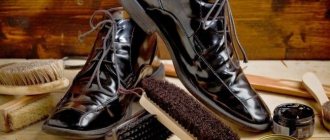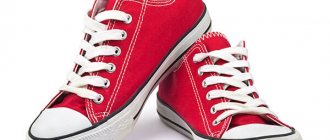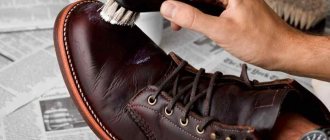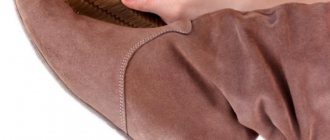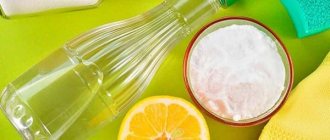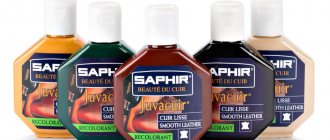Leather shoes are attractive in appearance, comfortable and practical to wear. It is considered strong, durable and can serve the owner for a long time. But all this will happen only if the rules of operation and care of the pair are followed. In this article we will look at how to properly care for leather shoes.
What are leather shoes afraid of?
Leather shoes are considered strong and durable. However, not everyone knows that she is also “afraid” of certain things.
So, what don’t you like about leather shoes?
- Intensive drying using heating devices. It should be dried at room temperature by filling the inside with paper or inserting wooden spacers.
- Dampness. Wet, poorly dried shoes become greatly stretched and deformed when worn.
- Silicone soaked sponges. Silicone clogs pores, preventing the removal of moisture. This does not apply to patent leather shoes and artificial leather.
- Gasoline, acetone and bleach. They destroy collagen fibers.
Caring for leather shoes at home also has its own rules, non-compliance with which can lead to damage and loss of performance.
Advice! It takes at least a day for leather shoes to dry completely under natural conditions. So if you plan to wear it every day, then don't skimp and get a pair to go with it.
Useful tips
With the right approach, leather shoes will last more than one season:
- Wipe your shoes with a dry cloth each time to remove settled dust - it may contain aggressive substances that corrode the skin;
- use special pads for storage: if the shoes are bent, creases and then cracks appear on the leather;
- do not use creams and shoe polish often and in large quantities: their excess leaves greasy stains that are difficult to remove;
- to protect the soles of winter shoes from exposure to aggressive reagents, use a special rubber sticker or regularly lubricate the soles with compounds based on animal fats;
- It is recommended to alternate shoes and not wear one pair for several days in a row: they should have time to dry naturally (about 12-20 hours).
Rules for caring for leather shoes
Caring for leather shoes includes daily cleaning, treatment with protective agents and proper storage. The order may vary slightly depending on the type of material, but the basic rules remain the same.
Basic rules for caring for leather shoes:
- You should clean it immediately after returning home. Some types of dirt can leave permanent marks if they are not removed immediately.
- Protective agents are applied several hours before going outside. They must be thoroughly absorbed to be effective.
- Leather shoes can only be dried under natural conditions, avoiding overdrying and exposure to heat.
- For care, you should use only those products that are intended for the type of material from which it is made.
- Leather shoes should be stored in cardboard boxes, after drying them thoroughly, lubricating them with emollient cream and inserting pads inside or tightly stuffing them with paper.
Also, there are nuances depending on what material the shoes are made of, natural or unnatural. You will learn further about all the features of how to care for shoes made of genuine leather and artificial leather.
...and cleaning “equipment”
The main and mandatory device for cleaning leather shoes is a brush. Natural or with artificial pile. Also have on hand:
- cream brush (separate for each color);
- polishing cloth;
- impregnation sponge;
- washing sponge or washcloth;
- soft rags;
- toothbrush (for hard-to-reach places).
Choose only high-quality brushes. Otherwise, you risk damaging your leather shoes with scratches and not being able to deal with dirt.
Caring for shoes made of genuine leather
Shoes made of genuine leather are considered one of the most durable, beautiful and comfortable. The leg breathes in it, the foot does not get tired. However, in order for her to retain all her positive qualities for a long time, she must be looked after daily:
- clean;
- dry thoroughly;
- treat with protective and softening agents;
- repair if damaged.
Processing after purchase
After purchase, it is necessary to treat the boots with water-repellent and other protective agents, which should be selected based on the material. You can immediately put “prevention” on the shoes; an additional pad is glued to the original sole, which will protect the original sole from wear.
To prevent new shoes from causing discomfort while wearing them, try to break them in. To do this, you can walk around in a new pair for several hours at home or purchase special softening sprays. They will help the boots adapt to the individual characteristics of the foot, but not how not to increase the size.
Smooth leather shoes
How to care for leather shoes with a smooth, untreated surface? For this type of material, short exposure to moisture is not dangerous and can be washed using a mild soap solution. Afterwards, wipe the surface with a damp sponge and wipe dry with a paper towel.
The next stage is drying. Shoes are stuffed with soft paper and placed in a warm, well-ventilated place. It takes a day or two to dry, depending on the degree of getting wet and the ambient temperature. Then the shoes are lubricated with fat-containing cream, allowed to be absorbed, and the remains are removed with a paper napkin. Finally, polish with a special velvet cloth or cloth.
Once a week, smooth leather shoes are treated with water-repellent impregnation. It is applied after the cream, allowed to absorb thoroughly, then polished.
Alternative to store-bought creams
To keep your shoes in perfect condition, you don’t have to spend money and buy special products. There are a number of folk methods that are as effective as store-bought cosmetics for shoes.
- Adding shine. Dilute a teaspoon of baby soap and a few drops of ammonia into 0.5 liters of warm water. Soak a washcloth in the solution and apply to the surface. You can also beat egg white, milk and sugar (in equal proportions), then cover the leather surface with the resulting foam. Finally polish with a rag.
- Protection against drying out. Dry tops of shoes or boots can be saved by treating them with castor or vegetable oil. To prevent the leather surface from cracking, use glycerin or petroleum jelly.
- Creating a water-repellent effect. Store-bought products will successfully replace flax oil. A popular method among people is to rub natural leather with unsalted lard.
- Removing unpleasant odors. A light solution of potassium permanganate will help remove odors from leather shoes. You need to thoroughly wipe the inside of the insoles and side walls with it, and then go over it again with a cotton pad soaked in pharmaceutical hydrogen peroxide. If you don't have potassium permanganate, you can just use peroxide.
It happens that cats choose leather shoes as a place for their toilet. If you need to get rid of such an annoying nuisance as the smell of cat urine, prepare an acetic acid solution: mix a tablespoon of vinegar with four tablespoons of water. Gently wipe the interior surfaces, then sprinkle them with baking soda for half an hour. Then rinse everything off and dry. To neutralize the stench, citric acid and vodka are suitable.
Patent leather shoes
Afraid of water, frost below -10 0C and heat above +25 0C. It becomes dull from water, and under the influence of temperatures that are prohibitive for it, it cracks. To care for patent leather shoes, use only special silicone-based products. They are applied to a surface cleaned with a damp cloth. Afterwards they are polished with velvet cloth.
How to clean leather shoes with a patent leather surface? If it is dark in color, you can try cleaning it with coffee grounds or dried tea leaves. Light-colored shoes are wiped with a cloth soaked in milk.
If the polish on your shoes has dulled and lost its shine, rub it with an onion cut in half, and then polish it with a cloth.
Removing stains
Home methods can also cope with solving more complex problems. It is quite possible to remove stains from leather shoes using folk remedies.
From dark products...
Peculiarities. It is best to apply any available means immediately after the stain appears. This way the fat will not have time to be absorbed and the shoes will be more likely to be preserved. Sprinkle fresh greasy stains with starch, chalk, baking soda or salt. After half an hour, clean it with a brush. Old greasy stains are removed with dishwashing gel.
Procedure
- The gel is applied with a sponge and then wiped with a damp cloth, leaving the surface streak-free.
- If the contamination turns out to be persistent, the procedure is repeated.
- During the process, avoid prolonged contact with the drug, especially if it is a rich green or blue color.
... and light
Peculiarities. Onions help to clean white leather shoes. First, the entire product is wiped with a fresh cut. Then use a dry cloth. Vegetable juice removes dirt and other stains. But there is a drawback - a very unpleasant smell that will last for several days. Therefore, the onion method is replaced by the egg-milk method, with a similar effect.
Procedure
- Raw protein is mixed with half a glass of milk.
- Use a sponge or rag to wash marks on shoes
New shoes
Caring for new shoes made of genuine leather consists of initial treatment with water-repellent impregnation and application of a protective cream.
The entire surface is treated with impregnation, then dried thoroughly. Then apply a thin layer of cream and polish.
It is also recommended to first wear your new clothes by walking around in it for a couple of hours at home. If it rubs, then rub the problem area with soap or a candle.
Special preparations for breaking in or cologne, which is used to moisten the inner surface of shoes, will help to stretch tight shoes.
A prophylactic (thin rubber sticker) should be applied to leather soles only after the shoes have been worn and “sat down” on the foot.
Recommendations for suede
According to most people, such material is one of the most whimsical. Maintaining its original appearance is not easy, especially with everyday wear. Suede quickly absorbs dirt and moisture, the product can be easily scratched if not cleaned correctly. To extend the service life and maintain the neat appearance of suede, you must adhere to the following rules:
- When cleaning, it is allowed to use soft rubber brushes so as not to damage the outer layer. Chemicals used to remove dirt must be very mild.
- Suede shoes are designed to be worn in dry weather. If exposed to rain, you should thoroughly wash your shoes, boots, and boots with soapy water and a small amount of alcohol. In addition, it is worth wiping your shoes with a clean cloth, after moistening the cloth with vinegar.
- With prolonged wear, shiny areas may form, which should be wiped with special brushes or a regular school eraser.
- Grease stains are especially dangerous for suede. The material quickly absorbs any dirt. You can cope with them using folk remedies. The most effective are talc, baby powder and potato starch. The selected product must be applied to the problem area and thoroughly rubbed into the surface with gentle circular movements. The main task is to allow the substance to penetrate the structure of the pile. You can wash off the product only after 3-4 hours. During this period of time, it is worth covering the shoes with a clean napkin so that they can absorb any remaining dirt.
You should not machine wash or keep suede shoes under water. You should wash off dirt immediately after contamination: otherwise it will be deeply absorbed into the structure of the suede.
Caring for faux leather shoes
Although such shoes are inferior in many respects to natural leather, they still have one undoubted advantage - they do not allow water to pass through! Therefore, you can safely wear it in rainy weather. High-quality leatherette will protect your feet from dampness and protect you from colds.
It is enough to wash it with soapy water, rinse with clean water and wipe with a clean cloth. Sports shoes can be washed in warm water with shampoo added. After drying, it is lubricated with silicone-based cream.
Remedies for black streaks and salt stains
Table vinegar is the most effective remedy for getting rid of white salt stains. First, wet shoes need to be completely dried, the basic requirements for their care must be met, and only then a solution must be prepared from one part water and three parts vinegar. Then wipe the dirty areas with the mixture until the streaks disappear. Castor oil will help eliminate stubborn salt stains.
A common problem is black stripes and streaks on white skin. Any spot stains and streaks can be removed with a regular school eraser, but always white. The result is clean shoes without dark stains.
What to choose?
Leather shoe care products are of the following types:
- cleansers (shampoos and foams) - to remove stains and remove dirt;
- caring agents (creams, emulsions) – restore, soften and provide other care;
- water-repellent (impregnations, polishes) – prevent the penetration of moisture;
- deodorants (deodorants) – have an antibacterial effect and eliminate unpleasant odors.
When choosing, you should adhere to the main rule - there is a different product for each type of shoe.
Leatherettes
Faux leather boots do not tolerate slush and dirt. These shoes are best worn in dry frosts. Despite this, caring for artificial materials also requires following basic steps. When processing it is necessary to use special creams for eco-leather.
Author:
Zakharova Nina Afanasyevna
I hope you like my article! If you find any shortcomings, just write to me about it! I am always ready for a conversation and will answer any questions you have, ask them!
